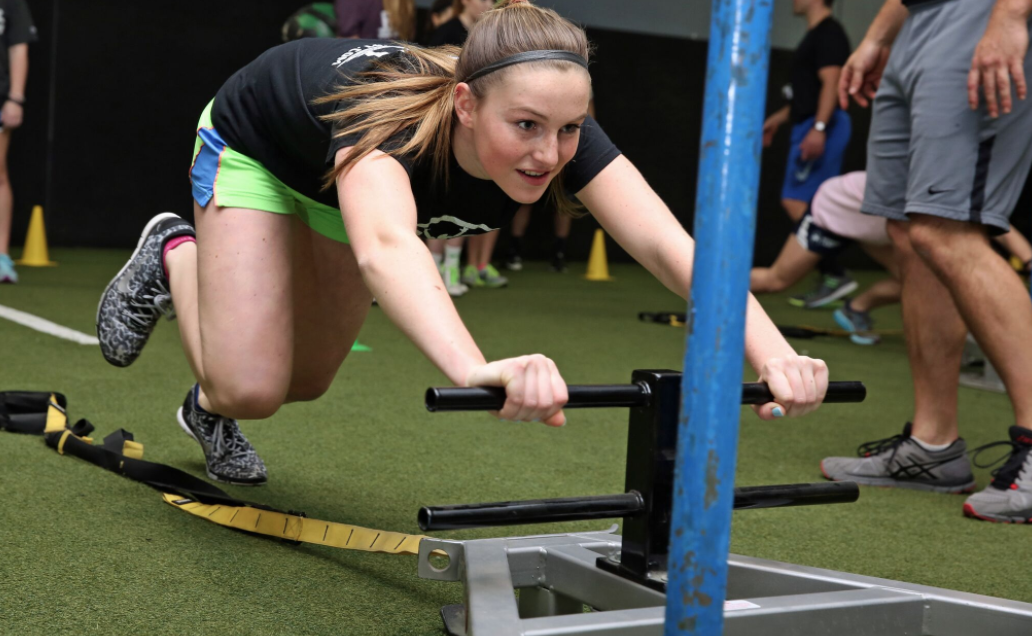Sleds Training for Acceleration Development – Part I
By: Bruce Kelly

When it comes to sprinters and hurdlers, and power athletes in general, they live and “die” by their ability to accelerate as well as their top end speed. This article is going to look at the use of another tool to help develop acceleration: the towing sled.
First of all, I believe that the sled is a good tool for enhancing acceleration and by that I mean the first 5-10 meters of a race. After that I feel it loses some of it’s effectiveness as it may alter mechanics and cause some one not to start to stand up to reach their upright sprinting posture. But for developing specific acceleration strength in those first 5-10 meters it will help teach the athlete to drive into the ground, use their arm drive aggressively, and overcome inertia.
What kind of load should one use? I would start with the standard recommendation of 10% of bodyweight and adjust from there depending on the ability, strength, and experience of your athletes. The key to look for, I believe, is how closely the sled allows the athlete to maintain close to normal acceleration mechanics. If it looks like they’re towing a small semi (i.e. hands on ground, crawling along) then it is probably too heavy. On the other hand if the load is too light the specific ground reaction force training you’re trying to develop may not happen.
Where would I use this in my training program? Whenever you’re working on acceleration development would be a good time. In the early preparation phases you might use it twice a week as a mode of specific strength training. As you approach the competitive season you could cut back to once per week. Although Barry Ross’s thoughts on this may alter your thinking on how often you could apply this type of training.
In implementing it into your program, I would keep the reps short(3-5 sec.) and rest/recovery long to allow for maximum effort on each rep and full recovery between reps and sets. For an advanced athlete a workout could be 2 sets of four 3 sec. efforts with 2 min. recovery between reps and 5 min. between sets. A less accomplished athlete may only do 1 set.
That seems like a lot of rest but this isn’t conditioning work and we are training sprinters, hurdlers, jumpers not middle distance runners! Quality over quantity every time should be our credo. The other advantage of this philosophy is that we could do this type of work more frequently because our athletes aren’t overtrained or their nervous systems “fried.” Much of this is based on your own coaching intuition and experience and how you feel your athlete is progressing.
One way to test the effectiveness of the use of sleds is to do some testing. Divide your athletes into two groups: one which will use the sleds in their training and one as a control group. Do some baseline testing of acceleration before you implement the sled protocol and then test again after that mesocyle (4-6 weeks). The results should either validate the method or you can discard it. I have found sled towing helpful especially with my athletes who have trouble aggressively developing that necessary ground force action into the track.
Where can you get a sled? There are a number of websites that sell sleds amongst them: www.elitefts.com (Westside Barbell’s site), www.performbetter.com, and www.power-systems.com. If those are beyond your budget then you can make your own sleds out of tires. With a weight belt, a length of sturdy rope, and a tire you have your sled.
Getting tires of various sizes for free just takes a few telephone calls because garages, construction companies, and utility companies are constantly looking for ways to rid themselves of their old tires. With an array of various weight/size tires you would have one that works for your smaller, less experienced athletes to one that works for your best, most powerful athletes. I had a client deliver me several 300 lb. tires because he was glad to get rid of them. More are on the way at no charge to me. Though these are too large for the towing work we’re talking about in this article you get the point.
Good luck if you decide to use sleds and let me know how it works out for your athletes and program.
Recommended Athletes' Acceleration
Products
—————————————————————————–




0 Comments for “Sleds Training for Acceleration Development – Part I”